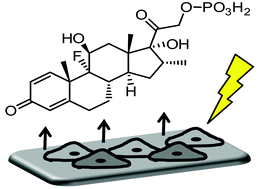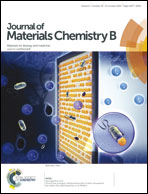Biodegradable electroactive polymers for electrochemically-triggered drug delivery†
Abstract
We report biodegradable electroactive polymer (EAP)-based materials and their application as drug delivery devices. Copolymers composed of oligoaniline-based electroactive blocks linked to either polyethylene glycol or polycaprolactone blocks via ester bonds were synthesized in three steps from commercially available starting materials and isolated without the need for column chromatography. The physicochemical and electrochemical properties of the polymers were characterized with a variety of techniques. The ability of the polymers to deliver the anti-inflammatory drug dexamethasone phosphate on the application of electrochemical stimuli was studied spectroscopically. Films of the polymers were shown to be degradable and cell adhesive in vitro. Such EAP-based materials have prospects for integration in implantable fully biodegradable/bioerodible EAP-based drug delivery devices that are capable of controlling the chronopharmacology of drugs for future clinical application.


 Please wait while we load your content...
Please wait while we load your content...